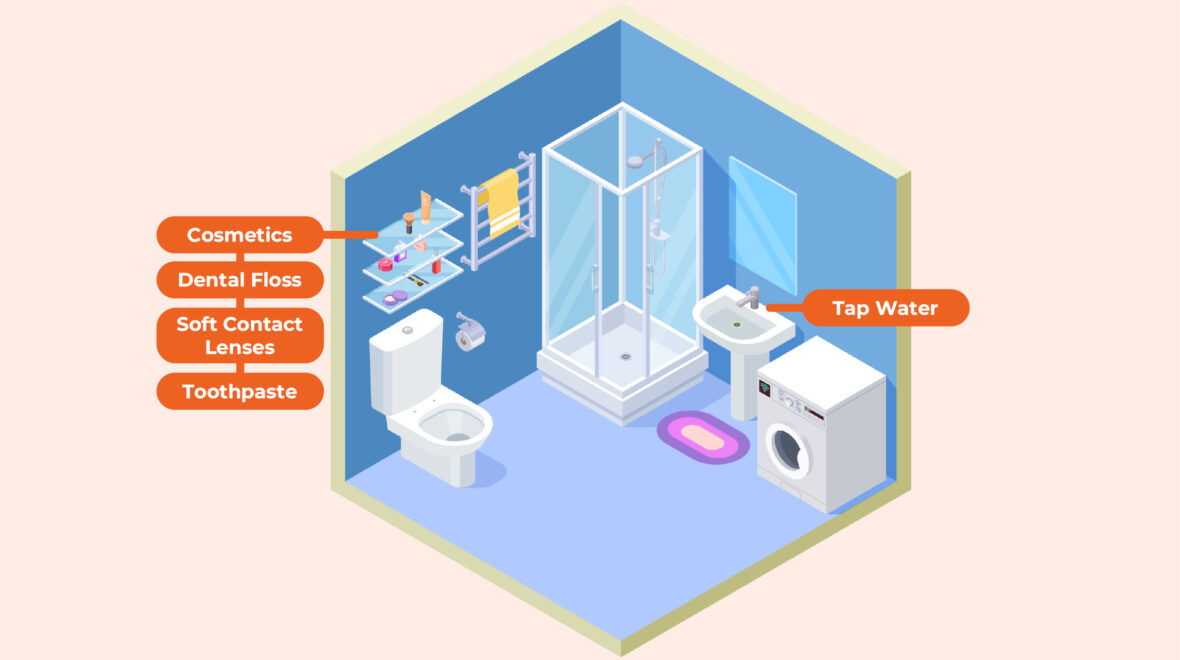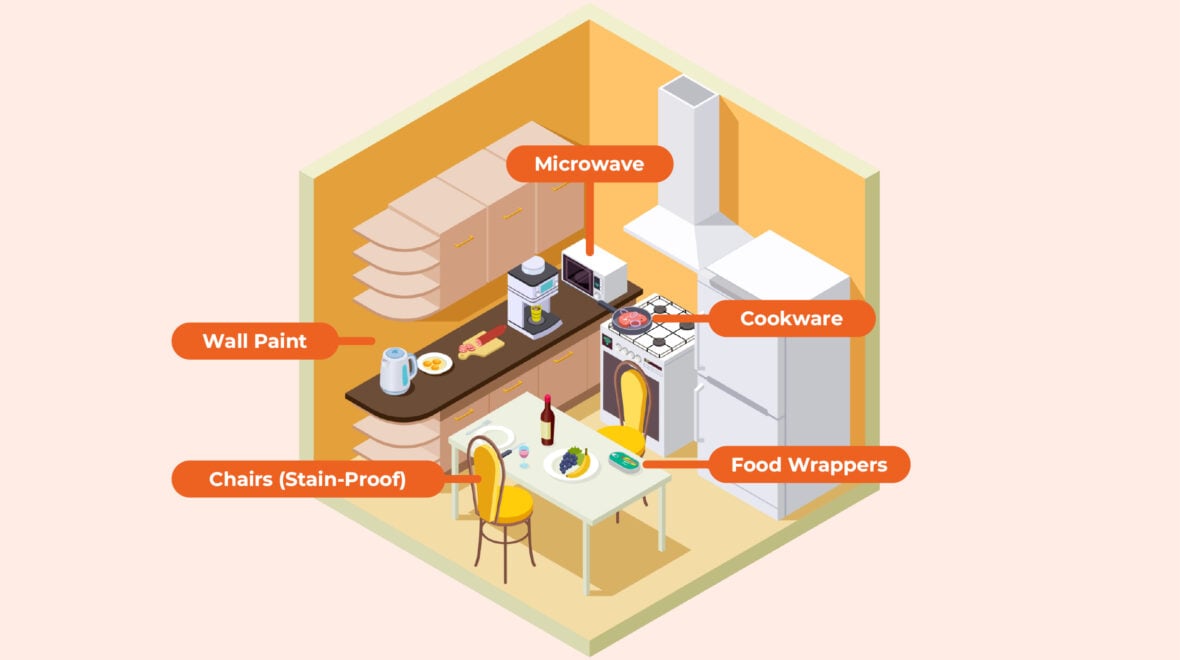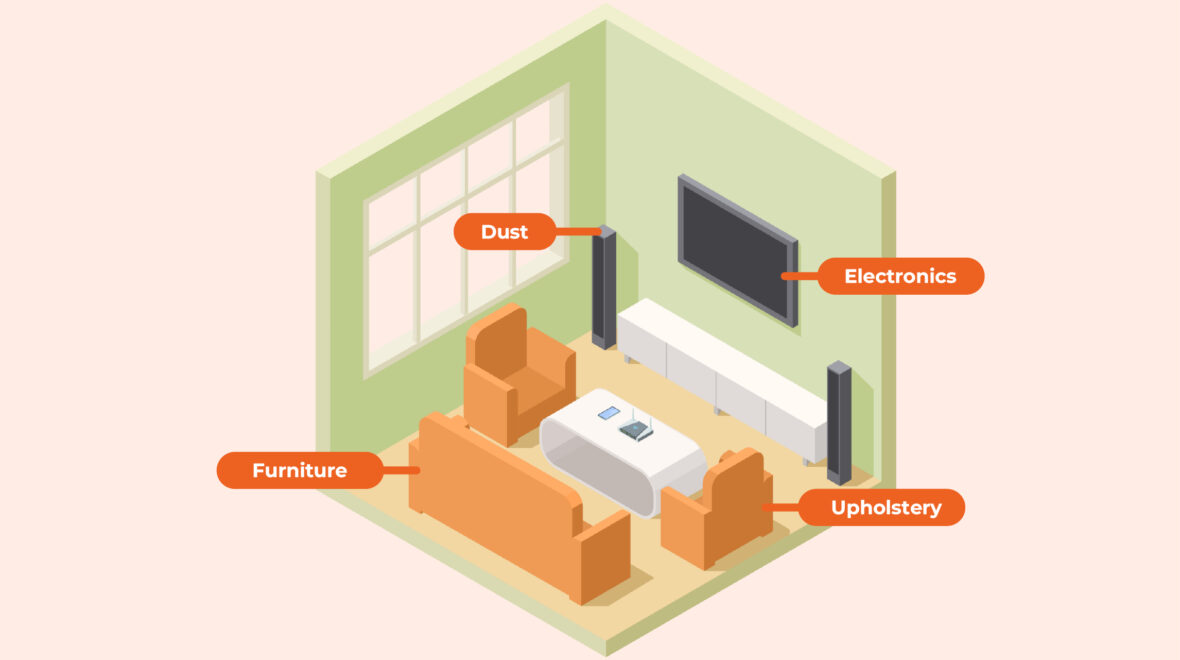The introduction of per- and polyfluoroalkyl substances (PFAS) into consumer products began in the late 1940s, but no one knew what kind of havoc it was going to wreak.
In this article, we’ll discuss how to avoid PFAS when it seems to be in everything from processed meats to our Gore-tex ski jacket. And here’s everything you need to know about ‘forever chemicals’ if they’re new to you.
How Forever Chemicals Made It Into Consumer Products
The first forever chemical, polytetrafluoroethylene (PTFE), was discovered in 19381. Chemist Roy Plunkett and chemical company DuPont saw the substance’s potential and developed it as the infamous nonstick cookware material now known as Teflon. Since then, PTFE and other forever chemicals have found their way into countless products like carpets, electric wires, medical equipment, and more.
Want to stay up to date on PFAS and the impact of forever chemicals? Sign up for the newsletter for more well-researched, non-toxic living guidance and smart wellness advice.
After the explosion of Teflon cookware, companies like 3M and DuPont continued to produce various forever chemicals with great success for decades. Inspired by the potential of materials like PTFE, individual scientists also found ways to get involved. In 1969, engineer Bill Gore and his son Bob Gore discovered that rapidly stretching PTFE caused an 800% stretch, resulting in a strong and porous material that we know today as Gore-Tex2.
Materials like Gore-Tex and Teflon are now household names, and they’ve undeniably made our lives more comfortable. But in more recent years, we’ve begun to witness negative environmental and health effects from the forever chemicals in our food, water, and consumer products.
To understand how widespread this issue is, it’s best to examine your own relationship with PFAS. What everyday products have PFAS in them, and what can you do to minimize your exposure?
Forever Chemicals in Our Water

Let’s start this off with some brutal honesty: in today’s world, there’s no way to entirely avoid forever chemicals.
According to Environmental Working Group (EWG) Deputy Director of Investigations and Senior Scientist, David Andrews, “The incredibly widespread use of these chemicals has led to contamination in nearly every person, indicating that it is nearly impossible to completely eliminate exposure. The biggest threat to health for the general population is the exposure that comes from the totality of our built environment.”
Due to their structure and ability to withstand almost anything, PFAS often ends up in our drinking water. This can happen in a number of ways, whether it’s from the trickle-down effect of chemicals in your sparkling water leaching into soil in the landfill, or from companies like DuPont dumping them directly into waterways3. And it’s not a small problem, either — a 2023 study found PFAS in nearly half of America’s drinking water4.
PFAS can escape products at every single stage of production and consumption to find its way into our water. Research even shows that PFAS are accumulating in the air and spreading via rainwater in most locations on Earth5. And because these chemicals are so persistent, they don’t disappear when they’re released into the environment — scientists predict they’ll persist for hundreds of years6. Eventually, wastewater will carry PFAS into the water cycle and then back out of our taps.
The incredibly widespread use of these chemicals has led to contamination in nearly every person, indicating that it is nearly impossible to completely eliminate exposure. The biggest threat to health for the general population is the exposure that comes from the totality of our built environment.
David Andrews, Deputy Director of Investigations and Senior Scientist at EWG
Forever Chemicals in Our Food
Another common way we might be exposed to PFAS is through the food we eat. Forever chemicals can find their way into our food through various stages of the production process. In some cases, our food indirectly becomes contaminated with PFAS via chemical-laden packaging. But in other cases, our crops are directly sprayed with pesticides that contain PFAS (it’s as terrifying as it sounds, and you can read more about it here).
Recently, new research aimed at identifying foods with higher levels of PFAS found that people who eat more white rice, coffee, eggs, and seafood typically showed higher levels of forever chemicals in their plasma and breast milk7. To understand how this might happen, let’s think about the humble coffee bean.
Potential PFAS Exposure in a Cup of Coffee
From coffee bean growth and harvesting all the way to your mug at home, let’s imagine how PFAS might enter your morning cup of coffee.

- Coffee plants flower three to four years after planting. During this time, it’s possible the soil the coffee plants grow in becomes contaminated by PFAS via pesticides or other water runoff (not to mention the potential to be exposed to other toxins like hormone-disrupting fungicides).
- Once the beans are harvested, they might be transferred into facilities that use PFAS in their machinery or in their protective gear for workers.
- After the beans make their way to your home or your local cafe, they might then encounter coffee filters that have been treated with PFAS — not to mention the likelihood that the beans are brewed with water that has been contaminated by PFAS.
- If you get your coffee in a to-go cup, it’s possible that PFAS may be present in the thin film of plastic (PLA) used to coat the paper cup.
As you can see, there are plenty of opportunities for PFAS to enter the equation — and the problem with forever chemicals is that once they’ve interacted with a product, it’s pretty impossible to eliminate them.
Recently, new research aimed at identifying foods with higher levels of PFAS found that people who eat more white rice, coffee, eggs, and seafood typically showed higher levels of forever chemicals in their plasma and breast milk7.
Avoiding Processed and Fast Foods
The more that our food comes into contact with machinery and other chemicals, the higher the likelihood (and concentration!) of PFAS exposure. This is one of the biggest reasons that one study found diets with more processed foods, specifically processed meats and tea (via plastic teabags), to result in a significantly higher accumulation of PFAS8.
Of course, those foods aren’t the only risks — even healthy foods can be wrapped in packaging that utilizes nonstick PFAS to keep everything as fresh as possible. And if you cook with nonstick pans made with PTFE or Teflon, you introduce even more PFAS onto your plate.
Having realized the risks, many fast-casual restaurants such as Cava and Nathan’s Famous are phasing out PFAS-contaminated materials from their packaging. Even fast food restaurants like McDonald’s and Burger King have set goals to remove PFAS from packaging by 20259. While these are great steps in the right direction, it’s important to keep in mind that this is a problem that’s larger than the occasional stop for a McFlurry and chicken nuggets.
The Forever Chemicals in Your Consumer Products
Look around your home and think about the products you use every single day. In all likelihood, many of the products you looked at contain PFAS. In fact, forever chemicals are so prevalent in items like our furniture, electronics, and personal care products that they ultimately spread PFAS into the air — meaning even the dust in our homes is likely contaminated10.
A Home Tour of the Forever Chemicals in Common Household Products
Bathroom

- Dental floss
- Toothpaste
- Shampoo and body wash
- Menstrual products such as tampons, pads, and Thinx period underwear11
- Cosmetics such as eyeliners, eye shadows, waterproof mascaras, nail polish
- Soft contact lenses
Kitchen
- Nonstick cookware
- Stain and water-resistant tablecloths and tabletops
- Parchment paper for baking
- Food wrappers
- Cleaning products and stain protection treatments
- Microwave popcorn bags

Living Room

- Stain-resistant furniture
- Carpets
- Upholstery
Bedroom
- Gore-Tex clothing
- Moisture-wicking clothing
- A 2023 study found that sweat pulls the PFAS additives from microplastics that are found in a large percentage of workout attire made from synthetic materials12
- Mattresses treated with water-resistant coatings

Garage
Miscellaneous
- Fast food wrappers
- Umbrellas
- Camping tents
- Ski or snowboard wax
- Sticky notes
- Wall paint
Pet Products
- Some pet food packaging
- Water-resistant or stain-resistant pet beds and blankets
- Flea and tick treatment
It’s important to note that manufacturers are beginning to phase out the use of these chemicals, so you can always look for PFAS-free alternatives. But just from this list, you can already see how difficult it might be to completely avoid forever chemicals.
The point of this list isn’t to alarm you, but to drive home the fact that most of us already interact with forever chemicals every day — the key is just to take small, conscious steps towards reducing our exposure.
How to Avoid PFAS: What Can You Do?
In an ideal world, it wouldn’t be our responsibility as consumers to monitor all our products for PFAS. And the more pressure that companies receive to eliminate PFAS, the closer we can get to that ideal world where our household products don’t contain carcinogenic chemicals.
But aside from continuing to put pressure on companies and pushing for large-scale government policy, it’s still helpful to understand how to avoid forever chemicals via individual actions.
EWG’s David Andrews notes, “An important first step in reducing exposure for most people would be checking if PFAS have been detected in their water and considering the use of a home filter.” If you live near a large water supply, the EWG has a searchable national tap water database that aims to collect drinking water quality data from public water utilities across the country.
Check to see if there is recent data on PFAS levels in your area, or if not, consider buying a home testing kit. If you have reason to believe your water contains forever chemicals, a granular activated carbon filter or a reverse osmosis water filter may help reduce PFAS levels.
An important first step in reducing exposure for most people would be checking if PFAS have been detected in their water and considering the use of a home filter.
David Andrews, Deputy Director of Investigations and Senior Scientist at EWG
Other Ways to Reduce PFAS Exposure

Aside from avoiding any products that you already know contain PFAS, consider taking some of the below steps to minimize your exposure to forever chemicals.
- Stop buying traditional nonstick pots and pans made with PTFE! Take a look at our list of non-toxic cookware and non-toxic bakeware for ideas.
- Stop buying wrinkle-free and waterproof products (or if you must, ask the manufacturer if their fabrics contain PFAS chemicals)
- Filter your tap water utilizing a home filter
- Support PFAS-free brands
- Avoid food packaging where possible
- Avoid processed meats (sorry, hot dog lovers!)
- Vote for politicians supporting stricter environmental policies
The good news is that we’re in this together. Regardless of who you are, it’s likely you’ve been exposed to forever chemicals already — don’t panic. By doing what you can to avoid PFAS wherever possible, you can still reduce your individual exposure as the country works to clean up its act (and more importantly, its water).
P.S. Did you know? Organic Authority has its own nutrition and wellness shop to meet your needs and help you take control of your health. Shop clean supplements for energy, sleep, inner beauty for skin support, protein, workouts, pantry items and more. Shop The Organic Authority Shop now.
Read More on Organic Authority

Sources:
- https://www.aps.org/archives/publications/apsnews/202104/history.cfm
- https://www.gore-tex.com/en_au/about/history
- https://www.ohchr.org/en/press-releases/2024/02/us-companies-dupont-and-chemours-generated-extensive-contamination-toxic
- https://www.usgs.gov/news/national-news-release/tap-water-study-detects-pfas-forever-chemicals-across-us
- https://www.bbc.com/news/science-environment-62391069
- https://time.com/6252365/pfas-raincoats/
- https://www.theguardian.com/environment/article/2024/jul/04/pfas-toxic-forever-chemicals-food
- https://www.sciencedirect.com/science/article/pii/S0160412024000400?via%3Dihub
- https://www.consumerreports.org/health/food-contaminants/dangerous-pfas-chemicals-are-in-your-food-packaging-a3786252074/
- https://www.sciencedirect.com/science/article/pii/S0160412024003428
- https://www.npr.org/2023/01/19/1150023002/thinx-period-underwear-lawsuit-settlement
- https://pubs.acs.org/doi/10.1021/acs.est.3c01894
Source link

